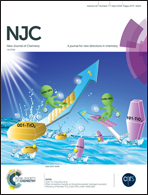Mechanistic insights into the catalytic carbonyl hydrosilylation by cationic [CpM(CO)2(IMes)]+ (M = Mo, W) complexes: the intermediacy of η1-H(Si) metal complexes†
Abstract
The mechanism of carbonyl hydrosilylation by cationic cyclopentadienyl molybdenum/tungsten complexes, [CpM(CO)2(IMes)]+ (M = Mo, W), has been investigated using density functional calculations. Earlier studies by Bullock and co-workers proposed that the ionic mechanism with the intermediacy of oxidative addition complexes of Mo(IV)/W(IV) silyl hydrides accounts for the catalytic reactions. The activation energies of the turnover-limiting steps along Bullock's proposed ionic catalytic cycles are calculated to be moderate, at 24.2 (Mo) and 20.6 (W) kcal mol−1, respectively. However, our calculations support an alternative ionic mechanism which features a SN2@Si transition state as the preferred reaction pathway instead of the ionic mechanism proposed by Bullock. The ionic SN2-type mechanistic pathway is initiated by the silane end-on coordination on metal centers, forming η1-H(Si) Mo/W complexes. Then, the carbonyl oxygen backside attacks the η1-silane metal adducts to prompt the cleavage of Si–H bond via SN2@Si transition states, giving silyl carbenium ion and metal hydrides. The rate-determining steps along the ionic SN2-type pathways correspond to heterolytic cleavage of the η1 coordinated Si–H bond and are calculated to be quite low, at 8.7 (Mo) and 7.4 (W) kcal mol−1, respectively. In this regard, our calculations reveal that silane end-on coordination on the metal center leads to stable η1-H(Si) Mo/W adducts, which are more stable, by 10.7 and 5.1 kcal mol−1, than the Mo(IV)/W(IV) silyl hydrides. Furthermore, the η1-H(Si) Mo/W adducts represent the intermediates of catalytic hydrosilylation reactions by two cationic molybdenum/tungsten complexes.
![Graphical abstract: Mechanistic insights into the catalytic carbonyl hydrosilylation by cationic [CpM(CO)2(IMes)]+ (M = Mo, W) complexes: the intermediacy of η1-H(Si) metal complexes](/en/Image/Get?imageInfo.ImageType=GA&imageInfo.ImageIdentifier.ManuscriptID=C7NJ03856A&imageInfo.ImageIdentifier.Year=2018)


 Please wait while we load your content...
Please wait while we load your content...